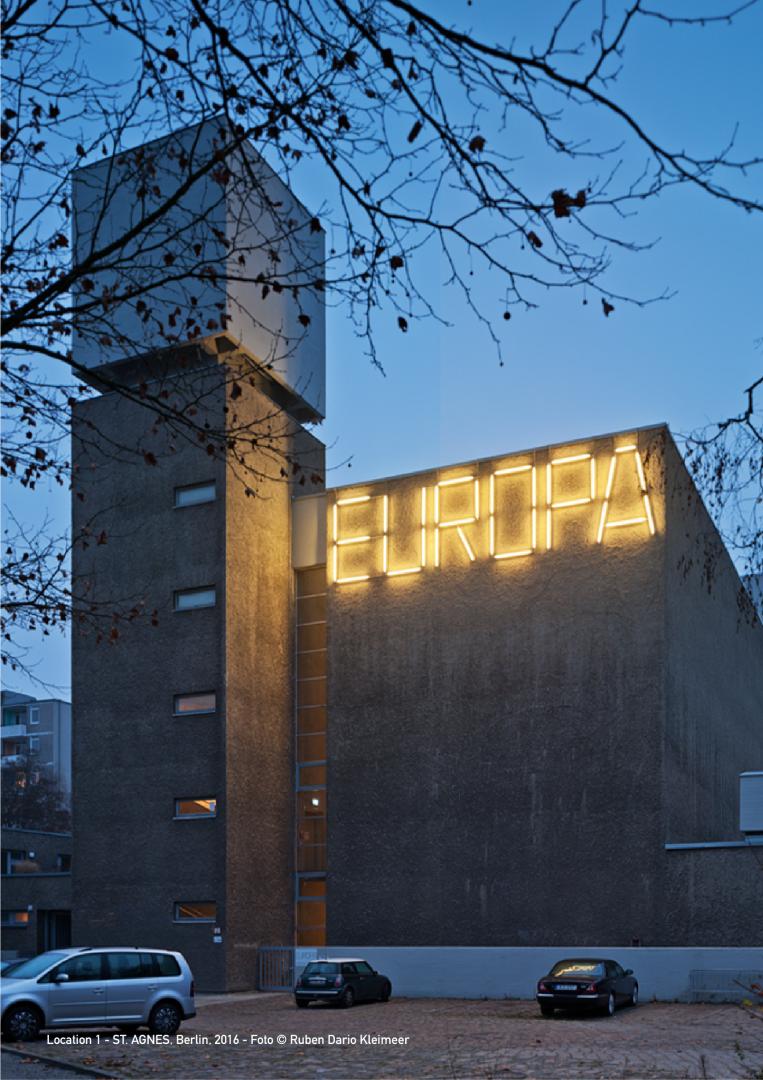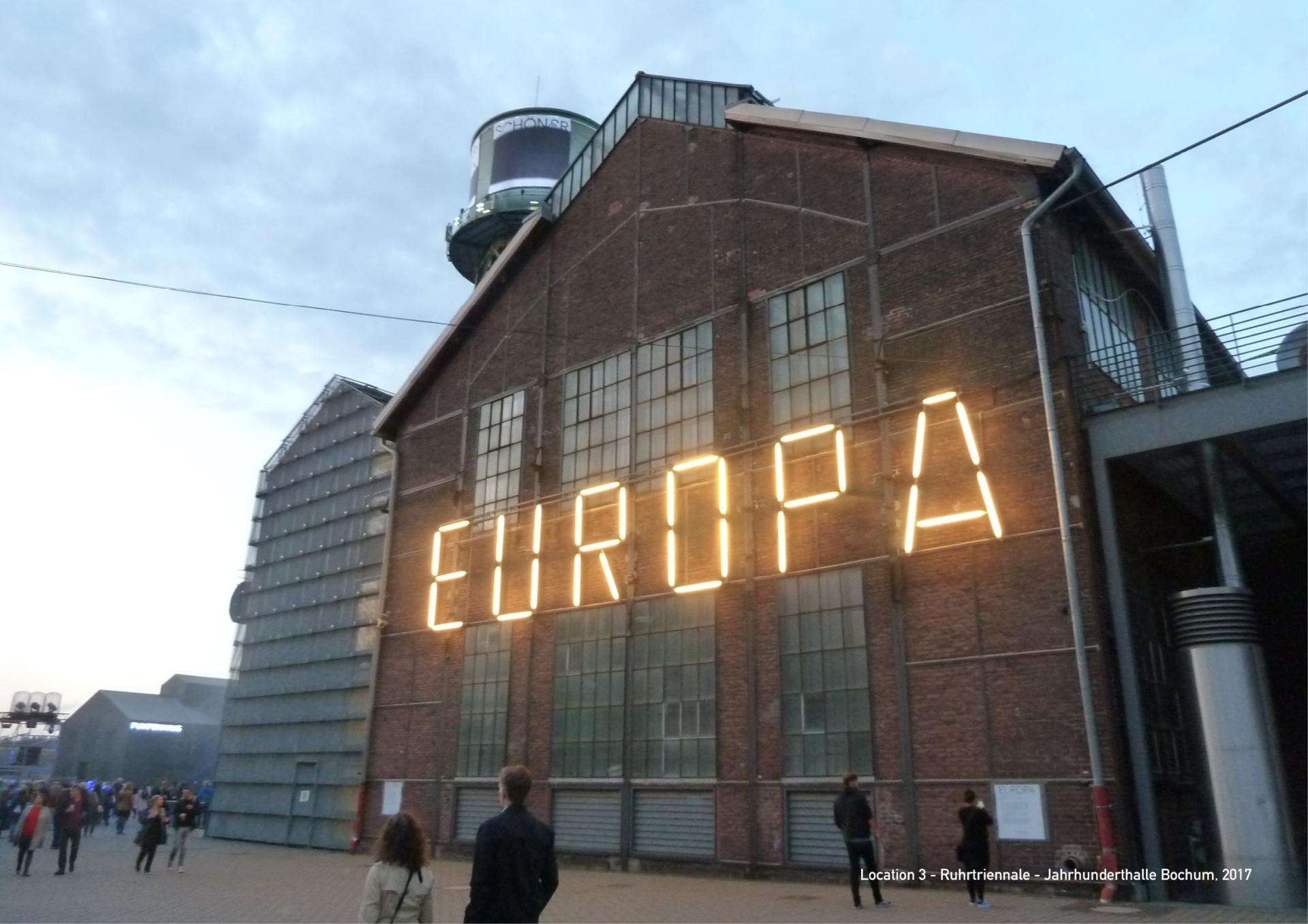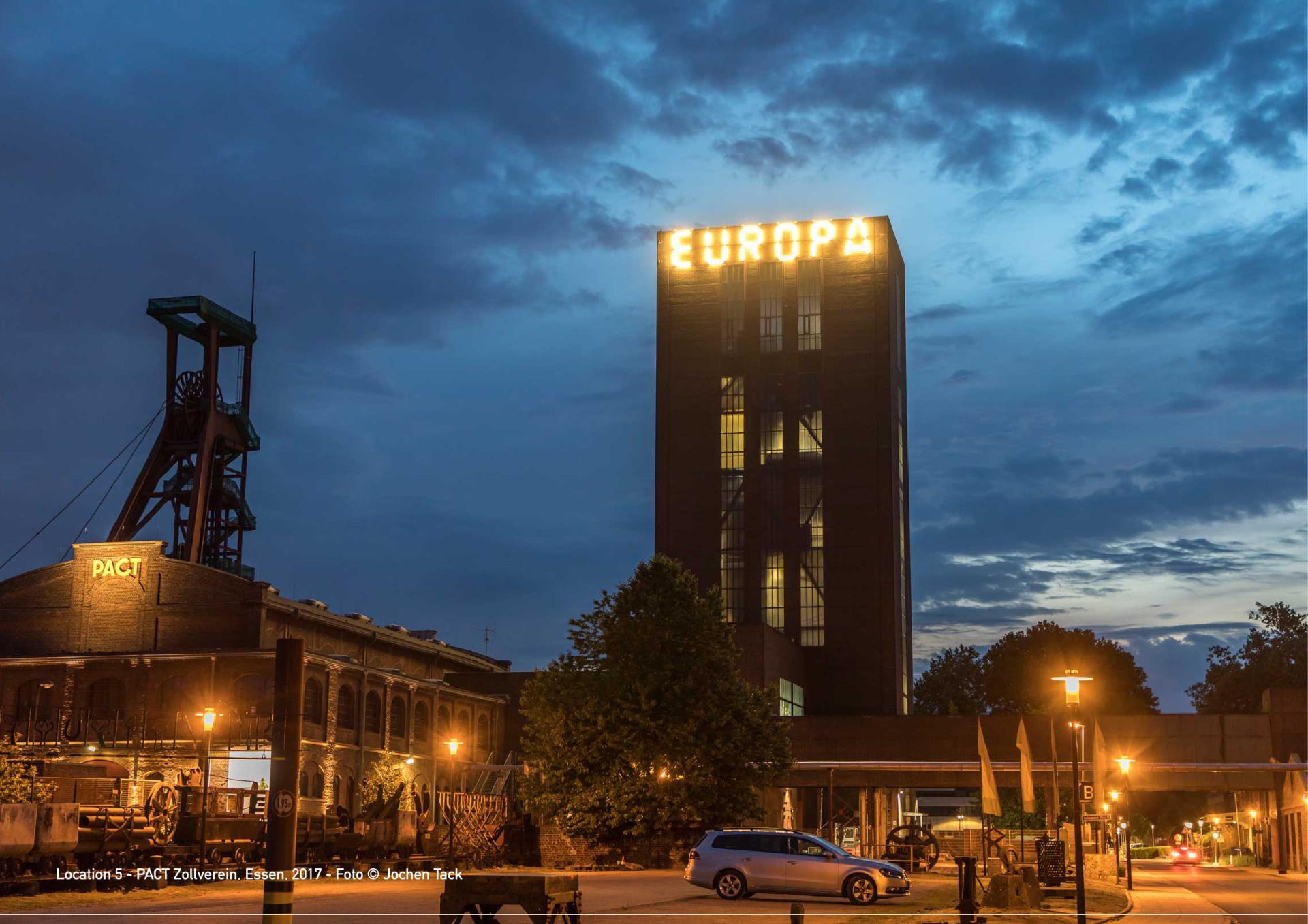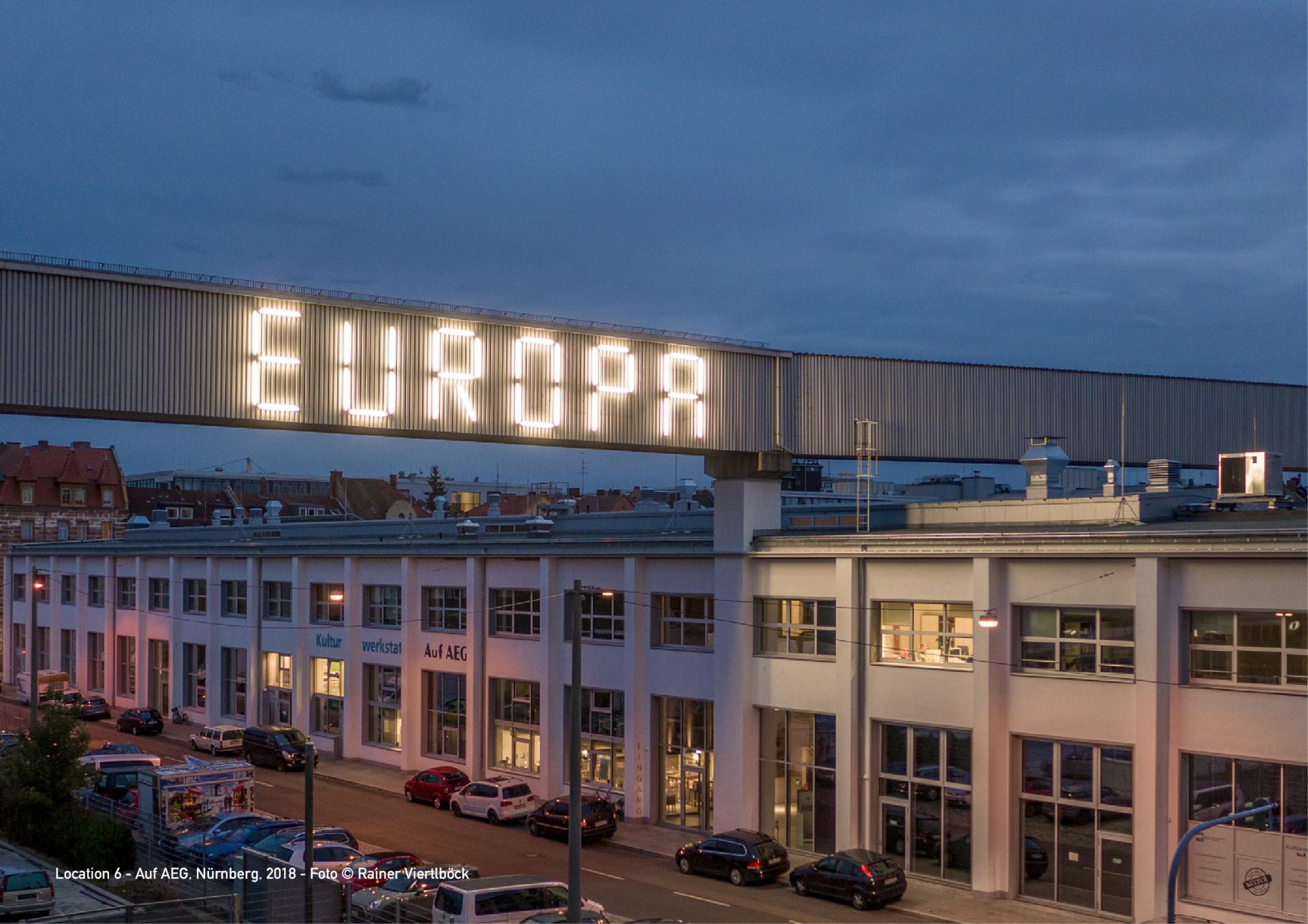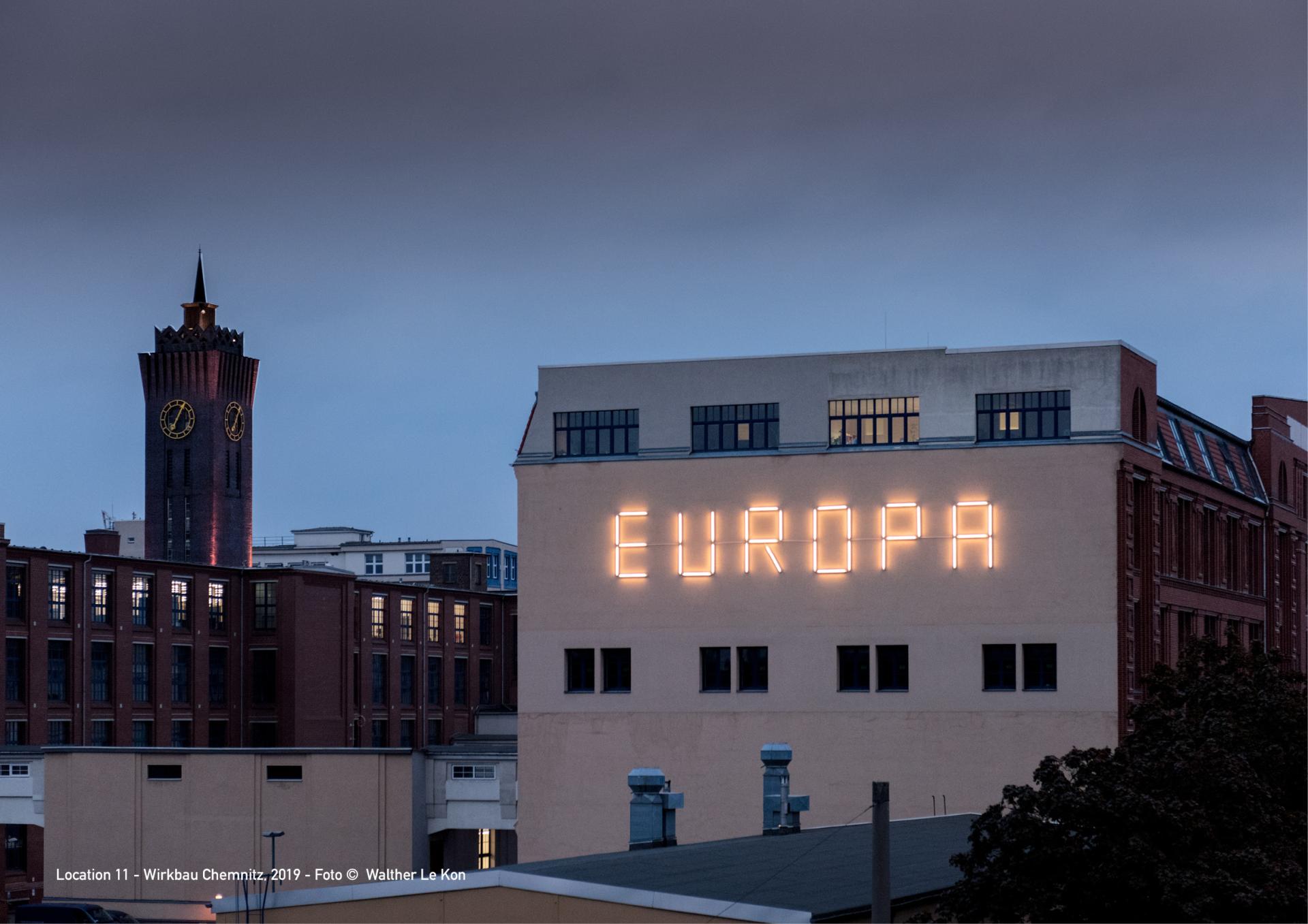EUROPA light installation
Basic information
Project Title
Full project title
Category
Project Description
The EUROPA light installation spells the word EUROPA by 33 neon lights and was initiated by morePlatz in 2016 shortly before the Brexit referendum. The project acts as a strong sign for the European values of solidarity, tolerance and openness and illuminates future tasks for Europe such as climate change and renewable energies. It started in Berlin at St.Agnes in 2016 and within the course of 4 years, was brought to 12 different locations in Bochum, Essen, Nürnberg, Hamburg and Chemnitz so far.
Project Region
EU Programme or fund
Description of the project
Summary
The EUROPA light installation consists of 33 neon lights spelling the word EUROPA and was initiated by morePlatz shortly before the Brexit referendum. The project acts as a strong sign for the European values of solidarity, tolerance and openness and illuminates future tasks for Europe such as climate change and energy transition.
EUROPA was first installed in November 2016 at the Königgalerie / St.Agnes in Berlin and moved after half a year to the stage tower of the Komische Oper at Unter den Linden. Within the course of four years the project was brought to twelve different locations so far. During the summer 2017 the sign was shining for the Ruhrtriennale at the Jahrhunderthalle in Bochum. Then, the UNESCO world heritage Zeche Zollverein offered a perfect location: being part of the European cultural heritage year 2018, the EUROPA light installation reached in Essen the roots of the European community and reminded of its historical aspects in the last year of coal production in North Rhine Westphalia.
The former mixing plant was hosting the exhibition „The age of coal. A European story“ where probably the most precious exhibit was the original founding charter of the ‘European Coal and Steel Community’ on display. The so-called Montan Union paved the way to the European Union.
The EUROPA sign shone from April till September 2018 onto the history of the Western European mining industry – its collaboration initiated not only the international domestic market but also prosperity and a peaceful coexistence.
Further locations were soon to follow - since 2018 EUROPA is permanently installed at the Europa Tempelmuseum in Etsdorf and at the ‘Auf AEG’ area in Nürnberg. In 2019, more permanent installations were mounted at the Kraftwerk Bille in Hamburg, at the Landschaftspark Duisburg and at Wirkbau in Chemnitz – the future European Cultural Capital in 2025. Last year the installation was shown at Tempelhof Berlin, a new location is planned in Munich this summer.
Key objectives for sustainability
Two thirds of the locations of the EUROPA installation are buildings that had been converted and refurbished for cultural functions. The aspect of reusing existing buildings instead if tearing them down and replacing them by new ones plays a big role in the so-called building transition since the build environment is responsible for 40% of the global CO2-emissions.
In the beginning of the project it was not foreseen, but during the course of the process - that will be described later - it came as no surprise that half of the locations of EUROPA are postindustrial buildings, such as the large structures of the former coal mines in Bochum, Essen and Duisburg. They fit to the EUROPA lettering not only in an esthetic sense. The historical aspect of the roots of the EU in the Ruhr area had already been mentioned.
But also the well-known electrical manufacturer AEG with its former headquarters in Nürnberg or the abandoned powerplant in Hamburg ‘Kraftwerk Bille’ and the converted production plant for textile looms in ‘Wirkbau’ Chemnitz are industrial sites that were refurbished and are now being reused, serving as a strong backgrounds for the EUROPA sign.
The conversion of industry into culture is characteristic for our current lifestyle and crucial for a sustainable society - the building and energy transition is opening up new potentials for vacant spaces that are enlightened by the EUROPA installation.
Initially, the original lettering was being reused and kept moving to its different locations. After the growing demand – when the sign started to multiply – we switched the neon lights into sustainable LED lamps with a reduced energy consumption. Future installations will be equipped with photovoltaic cells.
Key objectives for aesthetics and quality
The light installation EUROPA was conceived as a positive sign FOR the European project, in a phase where tendencies of disintegration and nationalism prevail. Europe often lacks visibility, public presence and positive feedback - the shining EUROPA lettering is so far realized in 12 different places in Germany, plus imagined or conceived for a number of other European places, in the UK, the Netherlands, Italy and Poland.
In each implementation the sign is profoundly connected to its architectural context, always in an interdependent relation since the lettering is adapted, arranged and mounted in reaction to the host-building. At the same time the radiance and meaning of the EUROPA installation influence the appearance and perception of a building and a given place.
In 2020 we launched a publication of the EUROPA project, that is on one hand a documentation of the journey of the installation in photos and texts, showing and explaining the very local historical and architectural context of each place where it was installed so far. This summary presents a collection of all places with their pictures and stories.
On the other hand the book is conceived as a continuation of the ideas of the project - by presenting the locations altogether, the printed media releases the local fixation, allows for a wider perception and for a new layer of reflection on the project.
By collecting concrete ideas and suggestions for improving and developing the European Project further, the publication widens the opportunities and the intended impact of the social engagement it is based on. The documentation is completed by additional texts which were produced or spoken at openings of the installation or panel discussions related with it.
These contributions by morePlatz and guest authors reflect on and elaborate the background layer of architectural implications of the project: e.g. the process of making, handling of listed buildings; industrial historic architecture, its situation.
Key objectives for inclusion
Since the EUROPA sign has so far only been installed in public space, it simply addresses everybody who looks at it. Its perception is literally ‘for free’ – public space is by default inclusive. Even on buildings where the access is restricted or linked to an entrance fee, like the Komische Oper Berlin or the state representation of Baden Württemberg, the perception of the project is entirely open to everyone passing by.
As architects we are professionally concerned with spatial qualities and have already implemented a number of installations in public spaces. Architecture and urban planning are profoundly linked to public space and art projects like the light installation help to vitalize the quality of the space in between buildings and city blocks. So far we always tried to find easily accessible locations with clearly visible surfaces, on which the lettering EUROPA brightly shines.
Originally, the 33 neon tubes that spell the lettering Europa were to be attached to the Europahaus on Stresemannstrasse - a building that used to be covered with neon signs all over in the twenties and with its dance theater and cinemas next to the Hotel Excelsior and the Anhalter Bahnhof formed a very lively district of Berlin.
This was the time when – a hundred years ago - Walter Gropius founded the BAUHAUS in Weimar - a school for architecture and design as a counter reaction to the advancing industrialization – beauty, style and composition on a human scale instead of mass production. Nowadays our new challenges are linked to the global long term effects of industrialization – climate change.
Since 2016 we have worked with EUROPA on a politically motivated project for the first time. Initially the lettering was designed to offer to the European project, that has continuously improved our living conditions for decades, a new radiance. Due to the events of 2019 and 2020 the focus shifted and our sign now shines at an even larger scale, addressing much more people - see below.
Results in relation to category
It was always our intention that the installation doesn't stay a oneliner but that we fill it with content and this is why we organized the ‘EU Talk’ event in 2017.
Almost synchronized with our idea for the installation, the artist Wolfgang Tillmans launched in England his EU campaign against Brexit. The posters visualize the European thought in a clear and striking way, address the public directly and name the advantages of the EU without any pathos. Since the posters kept their relevance even after the referendum we asked Wolfgang to relaunch the campaign for the 60th anniversary of the Roman treaties.
Europe is approaching a turning point, and it is imperative that we do not leave the field to pessimists. The decisions voters face today will affect the way many Europeans live.
It is important to emphasize this now, as in the past several years, it has seemed that fewer and fewer citizens identify with the EU. Yet a shared European identity can help stem the current nationalist tendencies and chart a future for Europe. The effect known as ‘Europeanization’- the conscious shift from a national to a continental identity—is key to these efforts.
The goal of the ‘EU talk’ was to collect proposals and ideas for an improvement of the EU and discuss these with activists, politicians, artists and architects, since art and architecture are able to evoke identity by creating sensory spaces.
Politics should shape sensible living conditions, but the bigger the spaces that one reflects, the more abstract are the means to describe them.
Politics uses words - which are the ultimate abstraction - and the event’s challenge was to open up new spaces by words. It raised the concrete question of what every one of us can do to contribute to a new European identity and to collect specific proposals for reforming, and strengthening the EU.
guests: Pulse of Europe, Matthias Sauerbruch Louisa Hutton, architects, Wolfgang Tillmans, artist, Klaus Lederer, Senator for Culture Berlin.
How Citizens benefit
The project originates from a sort of resistance against rejection - the growing rejection against the common project Europe, that - in our eyes - mainly has generated benefit.
Since many of our relations and acquaintances are architects and / or part of the creative sector, they share this opinion, as the European thought is based on collaboration and freedom of mobility. That is how we got the idea to realize the project via crowd funding. The 33 neon tubes stand for 33 sponsors from our private network, who each sponsored a lamp. The bottom up crowd funding became an essential part of the project.
The events of 2016 have caused a lot of friends and relations around us to counteract the negative trend that puts Europe into a bad light.
The decision of financing each neon light by private sponsors has rendered a new layer of meaning to the work. By this the process of fundraising developed into a beautiful experience and at the same time it allowed to many people to directly identify with the project.
Apparently, the installation hits a nerve of many like-minded and triggers a consent and willingness to carry the project further. With the help of our patrons, the Europa sign started to duplicate, since it was often one of the sponsors who came up with a new location.
This aspect of the work was not foreseen. The idea of the patronage was more of a counterstrike, since in the beginning funding was rejected by several official institutes. Meanwhile we found out, that it is mainly the initiative of our patrons that brings up proposals for new locations and that is why EUROPA not only spread but also multiplied.
This chain reaction came as a pleasant surprise and we owe it to our first patrons of the original installation. Willi Koch brought the sign to Tempelmuseum Etsdorf and it was Martin Schnitzer's idea to install it at "Offen auf AEG" Nürnberg which inspired Bertram Schulze to propose the Kraftwerk Bille in Hamburg and Wirkbau Chemnitz as new locations.
Innovative character
Since 2019, the global agenda is omnipresent in Europe. Especially the younger generation has understood that fundamental changes are necessary to maintain our co-existence on the planet. However, the possibilities of each individual to counter such serious problems as climate change or a pandemic in their daily lives are limited. Not even individual states can provide solutions independently. Progress and improvements for all can only be achieved through supranational cooperation.
From 2020 on, this has been more necessary than ever. The last two decades were characterized by an ever faster succession of ever-increasing crises. 2020 represents an absolute low point of this development. Can this also be a turning point? Can the corona crisis and the fight against its consequences result in a new global awareness? Can the ever enlarging radius of global jeopardies lead to the understanding that an all-encompassing political structure must be created in order to ward these off? That a world union is necessary?
The EU could serve as a model for transnational cooperation. A global political system that can effectively combat climate change and pandemics does not yet exist - but it can be built. Just as the EU has continued to evolve and transform, a process that is not yet complete, the United Nations would have to transform itself into a World Union with direct democracy and a supranational constitution.
The United States of Europe are still a vision, nevertheless a similar process for global institutions and a world parliament should be started right now in order to maintain and shape future existence on earth.
The next step of the EUROPA light installation suggests an alteration of the European treaties to define an approach towards the World Union - ‚Europe‘ is replaced by ‚world’. The logical progression of the installation foresees a light wall of 228 programmed letters displaying the World constitution consisting of thirteen LED strips each, on a 12x12m wall.

